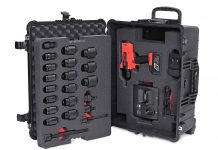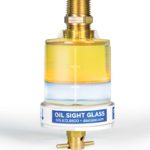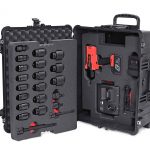During gearbox operation the gears churn air bubbles into the oil, which is called entrained air. The entrained air, being lighter than oil, rises to the top of the oil and builds up as foam. The entrained air bubbles that are generated are different sizes. The larger bubbles rise faster than the smaller bubbles, which is proven by Stokes’ Law. Stokes’ Law is a mathematical equation that expresses the settling velocities of small spherical particles in a fluid medium. This means that if two steel balls, one the size of a BB and the other one-half inch in diameter, were dropped into a container of fluid, the larger ball would arrive at the bottom faster than the small ball, due to gravity. The same principal applies to air bubbles. The larger air bubbles rise to the top of the fluid faster than the small bubbles, due to the larger bubbles greater buoyancy (Figure 1).
Additives are used to control foam. There are two types of antifoam additives: polysiloxane and acrylate polymers. They are both surface-active agents that reside at the air/oil interface. When looking at oil analysis reports, polysiloxane is the only one that can be detected, and it will show up as silicon. In addition to excellent antifoam qualities, acrylate polymers are designed to agglomerate small air bubbles into larger bubbles, allowing quick release of entrained air.
Foam is a colloid consisting of air bubbles suspended in the gear oil. The individual air bubbles are separated from the oil by a thin liquid film called the lamella. The main function of an antifoam additive is to lower bubble surface tension and weaken the lamella, causing the bubbles to burst so foam does not build up. Silicon depletes when in contact with moisture and can be filtered out easily, even when using standard 10-micron filter media and tends to work more at the air/oil interface or surface of the oil. Attempts to filter oils that use silicon antifoam additives with fine filtration to reduce the amount of moisture or particles can result in clean oil that foams.
 Because acrylate antifoam additives work to control entrained air and foam throughout the body of the oil, in addition to the surface, their concentration can be as much as 10 times that of silicon. Oils that use acrylate polymers as antifoam additives can be filtered with fine filtration without disrupting the antifoam performance, resulting in longer effective antifoam life and without the additive depletion associated with silicon antifoam additives.
Because acrylate antifoam additives work to control entrained air and foam throughout the body of the oil, in addition to the surface, their concentration can be as much as 10 times that of silicon. Oils that use acrylate polymers as antifoam additives can be filtered with fine filtration without disrupting the antifoam performance, resulting in longer effective antifoam life and without the additive depletion associated with silicon antifoam additives.
The ASTM D892 foam test evaluates the foaming characteristics of lubricating oils, including wind turbine gear oils. The test method is performed in three sequences: Sequence I, 24°C (75°F); Sequence II, 93.5°C (200°F); and Sequence III, 24°C (75°F). For each sequence, air is blown into the oil for five minutes, then allowed to settle for 10 minutes. The volume of foam in millimeters (ml) is measured at the end of the air blow and again after the 10 minute settle time. It is most important that the volume of foam in all three sequences after the 10 minute settle time is 0ml. When the 10 minute result is 0ml on used oil, it is a good indication the antifoam additive is working properly.
Two tests are used to evaluate the foaming tendency of oils. The ASTM D892 test method (Figure 2) is widely used and is the most cost effective. When using this test method, keep in mind that the temperature in a wind turbine gearbox will never get to the temperature in sequence II (200°F), so this sequence may not be as representative to field service as sequences I and II. Also, some analysis labs would like to see more severe testing to better determine the gear oil’s ability to control foam. An additional drawback to this test method is that it is limited to testing only foam and does not address the issue of entrained air.
The Flender Foam Test (Figure 3) is used in Europe and is currently not a standard ASTM test method. It is, however, quickly gaining popularity in the United States. It simulates the gear churning action through the oil that we see in a wind turbine gearbox, and evaluates both entrained air and foam as percent of volume increase versus oil volume at the start of the test. The drawbacks of this test include the cost and the lack of labs that offer this test in the U.S.
There are three factors that can reduce a gear oil’s ability to lubricate properly. All three are directly associated with increased wear: viscosity shear, excess water, and foam. Properly formulated oils like AMSOIL PTN which use acrylate antifoam additives eliminate the foam possibility, assuring oil performance is not diminished by foaming. Before changing oil, attention to the antifoam type in the new oil is highly recommended.
| (715) 392-7101 | www.amsoil.com | amsoil.inc | |||
| @AMSOILINC | amsoil-inc | ||||






































